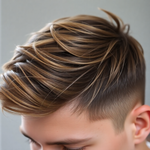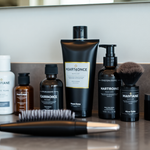
Dye to Declutter: How Semi‑Permanent Hair Color Can Streamline Your Sustainable Men's Capsule Wardrobe
22 September 2025
Share
Introduction
Struggling to look put-together without owning a closet full of one-off items? Semi-permanent hair color can be a surprisingly powerful tool for men building a sustainable capsule wardrobe. It creates immediate cohesion between your face and clothes, reduces outfit guesswork, and offers a reversible way to refine your personal palette. Read on for practical strategies, product tips, and a step-by-step plan to make hair color work for a simpler, more sustainable style routine.
Semi‑Permanent Hair Color: How it Streamlines Daily Choices
Think of semi-permanent hair color as another capsule piece — like a jacket or pair of shoes — that sets the tone for everything else. Because it’s less permanent than traditional dyes, it lets you experiment with tone, warmth, and contrast without the long-term commitment or heavy chemical maintenance. The result: fewer mismatched outfits, less impulse shopping, and a clearer visual identity that makes getting dressed faster and more intentional.
Why this matters for sustainable wardrobes
- Reduced buying: A cohesive, face-forward palette lowers the temptation to buy single-use trend items that don’t fit your core set.
- Longer wear: When clothes coordinate effortlessly with your natural look, you end up wearing core pieces more frequently.
- Lower maintenance footprint: Semi-permanent dyes typically require fewer salon visits and gentler formulas, which can reduce resource use over time.
How to choose the right semi-permanent shade (step-by-step)
- Audit your capsule: Lay out your core pieces and identify dominant color families and undertones (warm, cool, neutral).
- Decide your objective: Do you want contrast (darker hair with lighter clothes), harmony (matching undertones), or a seasonal shift (warmer in fall, cooler in summer)?
- Select a shade strategically: Aim for 1–2 levels of difference from your natural hair color for subtlety; add lowlights or highlights if you’re unsure.
- Test with temporary color or a strand test: Many at-home semi-permanent brands let you apply a small amount first to check compatibility and tone.
- Plan upkeep based on wash frequency: The less often you wash, the longer the color lasts — choose formulas and routines that match your lifestyle.
Color theory for real guys (practical pairings)
Simple rules will help you get it right without memorizing color wheels.
- Warm undertone wardrobes (camel, rust, olive): Choose warm chestnut, copper, or bronze semi-permanent shades to amplify cohesion.
- Cool undertone wardrobes (navy, charcoal, slate): Ash brown, soft black, or cool espresso tones will keep the look modern and matched.
- Neutral wardrobes (beige, cream, muted denim): Neutral or slightly warm shades add depth without competing with your outfit.
- Bold accent wardrobes (burgundy, mustard, teal): Use subtle lowlights or hints of warmth/coolness to let accent pieces stand out without clashing.
Building a capsule with hair color in mind
Design your capsule like you would a color palette in interior design. Pick 3–4 core neutrals, 1–2 complementary colors, and 1 accent. Then pick a hair shade that either harmonizes with the neutrals or provides controlled contrast.
- Example 1: Urban Minimalist — Core: black, grey, charcoal; Accent: deep navy. Hair: cool ash brown or soft black.
- Example 2: Rugged Earth — Core: olive, tan, cream; Accent: rust. Hair: warm chestnut with subtle copper lowlights.
- Example 3: Young Professional — Core: navy, camel, white; Accent: burgundy. Hair: medium brown with a neutral undertone.
Practical grooming and maintenance (save time and money)
One appeal of semi-permanent color is lower ongoing maintenance compared with permanent dyes. Follow these tips to keep the look fresh while minimizing effort and environmental impact.
- Choose a color-safe, sulfate-free shampoo and conditioner to preserve pigment and hair health.
- Wash with cooler water — hot water strips color and natural oils.
- Limit washing to 2–4 times per week; use dry shampoo between washes to maintain texture and freshness.
- Use leave-in conditioners or weekly masks to protect hair and reduce breakage, extending the life of both color and style.
- Avoid frequent high-heat styling; when you do use heat, apply a thermal protectant to reduce fading and damage.
At-home vs. salon: which route to take?
Both have pros and cons. At-home semi-permanent dyes are affordable and perfect for subtle changes and maintenance touch-ups. Salons offer professional color-matching and blending for more dramatic looks or if you want more complex lowlights/highlights.
- At-home: Cost-effective, convenient, a good option for small tone shifts and repeat applications.
- Salon: Best for first-time transformations, textured blending, or if you require color correction.
Safety, patch testing, and trusted guidance
Always patch-test new color products 48 hours before full application. If you have sensitive skin or scalp conditions, consult a dermatologist first. For reliable, evidence-based info on hair-dye safety and allergy testing, refer to resources such as WebMD: WebMD on hair dye facts.
Styling gear and product picks
Choose styling products that support texture and define the look you want. For a capsule wardrobe, favor versatile, multi-use products.
- Matte paste or fiber — good for everyday textured looks.
- Lightweight cream — for a polished, slightly glossy finish that works with smart-casual outfits.
- Sea-salt spray — adds grit for casual, layered looks.
- Dry shampoo — extends time between washes and preserves color.
For capsule-ready footwear and layering pieces, Menll.com’s EcoSneak Casual Shoes are a neutral, durable option that pairs with most hair-and-wardrobe combos. If you're building a capsule for fall or winter, check out Menll.com’s outerwear collection to anchor your core pieces: Menll.com outerwear.
Actionable 30-day plan: Try a two-week test, then commit
- Week 0 — Audit: Photograph your current wardrobe and pick 15 core pieces you wear most.
- Week 1 — Test: Try a temporary or semi-permanent strand test to confirm undertone and maintenance needs.
- Week 2 — Apply: If satisfied, apply a full semi-permanent color (at home or salon). Adjust styling products to complement the new tone.
- Week 3 — Rotate: Commit to wearing your 15 core pieces and note which items suddenly work better or worse with the color.
- Week 4 — Optimize: Replace one mismatched item with a neutral piece that harmonizes with both hair and capsule.
Real-life case studies (quick examples)
These mini-profiles show how a hair tweak simplified real wardrobes.
- Case A — Marcus, 28, creative agency: Switched from sun-faded brown to a cooler ash brown. His navy blazers and grey tees read cleaner; he stopped buying cheap white tees that clashed and now invests in higher-quality neutrals.
- Case B — Jamal, 34, teacher: Added warm chestnut lowlights to deepen his natural black hair. His olive and tan outerwear now feels intentional, and he reduced weekend shopping by avoiding one-off buys that didn’t match.
- Case C — Liam, 22, student: Experimented with copper-toned semi-permanent dye for 8 weeks during fall. The pop of warmth made his rust sweaters feel like new pieces rather than seasonal clutter.
Troubleshooting common issues
- Fading too fast: Check shampoo ingredients (avoid sulfates) and reduce wash frequency. Use color-refreshing treatments when needed.
- Color too warm/cool: Try a semi-permanent toner or wait for gradual fade and tweak with a cooler/warm touch-up.
- Patchy results: Consider a salon touch-up or use a color-depositing conditioner for even coverage.
- Regret a bold change: Semi-permanent dyes fade over 4–12 weeks depending on product and care — in most cases the look is reversible with time or a targeted color-depositing product to neutralize tones.
Sustainability checklist
Make hair-color choices that align with a low-waste, sustainable approach to style.
- Pick brands with transparent ingredient lists, smaller packaging, and recyclable containers.
- Choose ammonia-free or lower-impact semi-permanent formulas when possible.
- Stretch product life by minimizing washes and using concentrated treatments sparingly.
- Favor at-home maintenance over frequent salon visits if your goal is to reduce the carbon footprint — balance this with the benefit of professional correction when needed.
Audience-specific tips
Different lifestyles demand different approaches. Here’s how to adapt the concept across life stages and budgets.
- Young professionals (20s–30s): Aim for subtlety and invest in 2–3 high-quality neutrals for quick outfit choices before meetings or dates.
- Field workers/travel-heavy jobs: Choose darker, lower-maintenance shades that hide dirt and require minimal touch-ups.
- Budget-conscious shoppers: Use semi-permanent color to refresh old pieces in your wardrobe’s palette rather than buying new items.
- Style-oriented creatives: Use semi-permanent color seasonally to shift mood without committing to permanent changes.
Further reading and trusted resources
For safety and detailed ingredient information, consult healthcare and dermatology resources. A reliable primer on hair dye safety and allergy testing can be found at WebMD: WebMD on hair dye facts. For capsule-building guidance, see Menll.com’s guide to building a functional wardrobe: How to Build a Capsule Wardrobe.
FAQs
- How long does semi-permanent hair color last? Typically 4–12 weeks, depending on product, hair porosity, and wash frequency.
- Will semi-permanent color damage my hair? They’re generally gentler than permanent dyes, but overuse and harsh styling can still cause dryness. Use conditioning treatments.
- Can I go back to my natural color easily? Yes — semi-permanent shades fade gradually; some may require a few washes or a color-correcting conditioner to neutralize tones.
- Is it expensive? Not necessarily. At-home options are inexpensive and last multiple applications, while a salon visit is pricier but offers precision.
Final checklist before you dye
- Patch-test 48 hours in advance.
- Confirm undertone match with your core capsule pieces.
- Choose a low-impact formula if sustainability matters to you.
- Plan maintenance: pick color-care shampoo and a simple styling routine that fits your schedule.
Conclusion and single gentle call-to-action
Semi-permanent hair color is an accessible, reversible way to reduce outfit friction and make a sustainable capsule wardrobe feel more intentional. It helps you wear what you already own with confidence, spend less on trend-driven items, and simplify daily decisions. Ready to streamline your style? Pick a subtle shade that complements your capsule, run a two-week test, and see how much simpler getting dressed can become. Which pairing will you try first — ash with monochrome or warm chestnut with earth tones? Share your pick in the comments, tag a mate who needs this, or browse Menll.com for capsule-ready pieces to match your new look.
Vorheriger Beitrag

Use Semi-Permanent Hair Color to Cut Clothing Waste — Practical Steps to Build a Sustainable Men's Capsule Wardrobe
Aktualisiert am 23 September 2025
Nächster Beitrag

Pack Light, Look Sharp: How Semi‑Permanent Hair Color Simplifies a Sustainable Men's Capsule Wardrobe
Aktualisiert am 21 September 2025





